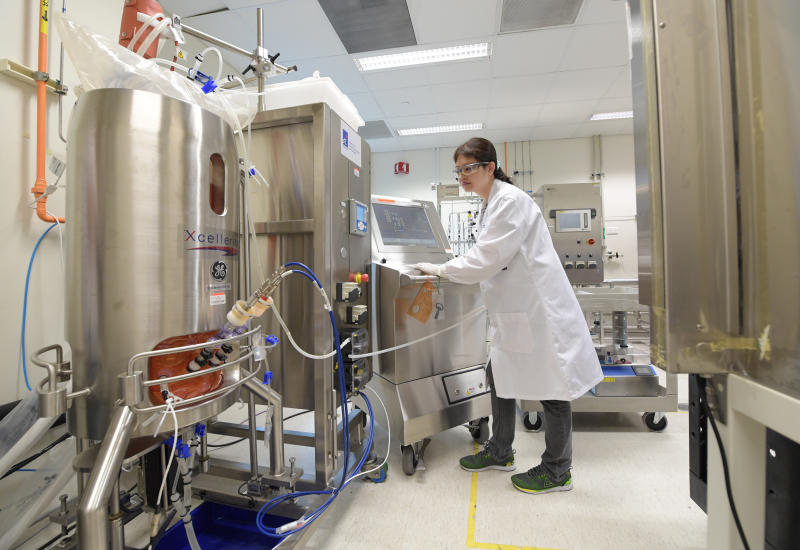Future food: Growing meat in lab to help meet supply needs
Sign up now: Get ST's newsletters delivered to your inbox

Leveraging its existing technology in bioproduction and stem cell bioengineering, A*Star's Bioprocessing Technology Institute is a first mover in culturing meat, and it is currently using Chinese hamster ovary cells in trials.
ST PHOTO: ALPHONSUS CHERN
Follow topic:
SINGAPORE - It is clean, has a low-carbon footprint and does not involve any killing.
Lab-grown meat is a key protein alternative of the future, and could soon be making its way to dinner plates here as Singapore ramps up production of home-grown food.
Rearing livestock such as cows, sheep and chickens is no longer sustainable in the face of climate change.
Animal agriculture emits large amounts of greenhouse gases. If the earth heats up by 2 deg C, 13 per cent of the ecosystem hosting plants and animals will be lost.
Meanwhile, Singapore's population is increasing and its nutritional needs comprise 25 per cent protein. High-tech and high-intensity farming will produce the food of the future.
To guard against food supply vulnerabilities and ensure that the country meets its meat needs, researchers are starting to grow them - from cells in the lab.
Stem cells extracted from chickens, cows, fish or pigs will grow and multiply in bioreactors and eventually undergo tissue engineering to make whole meat cuts.
Leveraging its existing technology in bioproduction and stem cell bioengineering, A*Star's Bioprocessing Technology Institute (BTI) is a first mover in culturing meat, and it is currently using Chinese hamster ovary cells in trials.
Under the Government's Research, Innovation and Enterprise (RIE) 2020 plan, $144 million will be allocated to fund projects in the Singapore Food Story R&D Programme, which includes growing meat in labs.
The cells are first stored in sterile flasks and are fed a red solution containing nutrients, such as high-grade amino acids and glucose, and growth factors for the cells to multiply and grow in a layer at the base of the flask.
After 1.5 to two months, the cells in the flasks will then be transferred to bioreactors where they will grow in a bigger pool of red solution, known as the culture media, under controlled conditions.
Probes are attached to the bioreactor so that scientists can monitor and adjust the temperature and amount of dissolved oxygen in the solution.
When the cells are harvested, they will look like a pinkish paste which needs to be mixed with other ingredients to create "minced meat" products such as patties, sausages and dumpling filling.
To create meat cuts and steaks, tissue engineering must be employed.
The cells will be mixed with scaffolds to provide structural support for them to interact with each other and form tissues.
Eventually, for both meat cuts and minced meat, the cells will comprise only 20 to 50 per cent of the meat, but its nutritional value will be similar to that of traditional meat, said Dr Kelvin Ng, head of strategic innovation at BTI.
"This is how cultured meat differentiates from plant-based meat or other kinds of proteins. We expect this to be genuine meat."
At the end of the year, he hopes to start making chicken meat in the lab by reaching out to local farms to extract cells from live chickens.
Apart from A*Star, other biotech companies here are also culturing cells for food. Local start-up Shiok Meats focuses on growing seafood in the lab.
Almost 30 per cent of Singapore's nutritional needs will be locally produced by 2030, under the "30 by 30" target.
Some reports predict a five- to 10-year timeline for cultured meat products to be commercially available.
Since research on lab-grown meat is still nascent, only minced meat and fillings are likely to hit the shelves by 2030, added Dr Ng.
"Cultured meat products like minced meat or meat fillings are also easier to develop than a slice of beef steak or chicken fillet, which would require additional technology to create the texture, mouth-feel and taste that consumers are looking for."
One of BTI's current focus is to make alternative meats affordable for the public once they can be commercialised.
Cultured meat is currently expensive globally because the culture media used to feed the cells is costly.
In 2013, 1kg of cultured meat cost US$2.4 million. In 2017, the price dropped to US$5,000. The most recent claims are about US$11 (S$14.90) for a meat patty, said Dr Ng.
"The prices have been going down, but it is still very expensive."
A whopping 55 to 95 per cent of production costs cover the cost for the culture media.
As the culture media currently available is primarily used in the pharmaceutical industry, it needs to be of high grade.
On potential ways to reduce cost, Dr Ng said: "One approach is to develop food-grade equivalents of culture media, which would reduce costs substantially.
"Another approach is to explore alternative raw materials, such as plant and microbial extracts, or adopt more efficient manufacturing approaches like continuous bioprocessing or recycling culture media."

